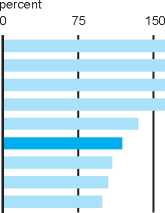6. Growth in venture capital, 1997-99
Pacific
Southwest
Mid Atlantic
Southeast
Mountain
Midwest
New England
Plains
South Atlantic

Source: PriceWaterhouseCoopers.
225 300
7. Venture capital, 1997
|
Region |
Dollars per |
Region |
Total |
|
Pacific |
37 |
Pacific |
5,075 |
|
New England |
31 |
New England |
1,469 |
|
Mountain |
13 |
South Atlantic |
1,369 |
|
South Atlantic |
10 |
Mid Atlantic |
1,125 |
|
Mid Atlantic |
9 |
Southwest |
744 |
|
Southwest |
9 |
Mountain |
630 |
|
Plains |
7 |
Midwest |
542 |
|
Midwest |
4 |
Plains |
393 |
|
Southeast |
4 |
Southeast |
168 |
Note: GSP is gross state product.
Source: PriceWaterhouseCoopers.
Conclusion
Technological change continues to
have startling implications for the na-
tional economy, as well as for states
and regions. Currently, the IT boom,
and related productiv-
ity revival, have refo-
cused regional policy
leaders to thinking
about how to position
their regions to thrive
in the new economy.
As past experience
and technology rank-
ings suggest, there are
no easy answers as to
which regions will
succeed or how they
should focus their
policies and resources.
Looking at how tech-
nology is changing the
global marketplace,
regional policymakers
may do well to consider
what role technology
and entrepreneurial
climate play in their
home economies. How
can a region’s human
and physical assets, in-
dustrial concentrations,
and business environ-
ment be parlayed into
a successful economy
going forward? We be-
lieve that because of the inherent ad-
vantages of proximity for some IT/
HT activities, not all regions can be-
come the hotbeds of rapid new econ-
omy growth that they hope to be.
However, the new economy has many
dimensions, offering alternative ave-
nues for regional growth and devel-
opment. In setting a course for
successful adaptation to a changing
economic landscape, each region
may benefit from identifying, and
then further developing, its own par-
ticular assets and opportunities.
—Richard Kaglic
Economist
—William Testa
Vice president and director
of regional programs
1The regions discussed in this article are de-
fined as follows: Midwest—IL, IN, MI, OH,
and WI; New England—CT, MA, ME, NH, RI,
and VT; Mid Atlantic—NJ, NY, and PA; South
Atlantic—DC, DE, FL, GA, MD, NC, SC, VA,
and WV; Southeast—AL, KY, MS, and TN;
Southwest—AR, LA, OK, and TX; Plains—
IA, KS, MO, MN, ND, NE, and SD; Mountain—
AZ, CO, ID, MT, NM, NV, UT, and WY; and
Pacific—AK, CA, HI, OR, and WA.
zv6L ιιι∕∖ιa3d
31 'OOV□IH□
αιvd 39vιsod s∩
3∣vι∕∖ι ssv3□ ιsa∣d
a31aos3ad
pəjsənbə,ɪ əɔɪʌ,ɪəs шщэу
τιιszzε (zɪɛ)
!£8006909 s!ou!ΠI ,oSb□i43
K8 χ°a о з
jθiuəɔ uo∏piujojuj σ∏qnj
OOV□IH□ HO MNVQ hλhhshh hvhhghh
лэда^ pəj oiteɔɪpɔ
More intriguing information
1. TOWARD CULTURAL ONCOLOGY: THE EVOLUTIONARY INFORMATION DYNAMICS OF CANCER2. The name is absent
3. Handling the measurement error problem by means of panel data: Moment methods applied on firm data
4. The Macroeconomic Determinants of Volatility in Precious Metals Markets
5. From music student to professional: the process of transition
6. Income Taxation when Markets are Incomplete
7. Housing Market in Malaga: An Application of the Hedonic Methodology
8. An Incentive System for Salmonella Control in the Pork Supply Chain
9. The Impact of Optimal Tariffs and Taxes on Agglomeration
10. What Contribution Can Residential Field Courses Make to the Education of 11-14 Year-olds?